Kinds of Quadrilaterals
Now, let's look into the classifications of quadrilaterals based on the type of sides and angles it consists of. We can look at the

(1) Trapezium
The
Usually, they consist of only one pair of opposite parallel sides. If the quadrilateral has two pairs of opposite parallel sides, the quadrilateral is further classified, as we will see further on.
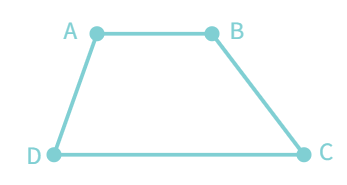
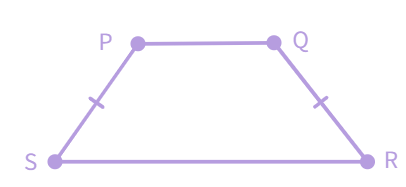
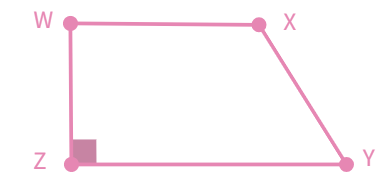
Trapeziums can further be divided into the following types:
Scalene Trapezium : The non-parallel lines are unequal in length.
Isosceles Trapezium : Non-parallel lines are equal in length.
Right Trapezium : Has atleast two adjacent right angles.
Let's try out an activity.
Using paper, make identical cut-outs of a triangle with sides 3 cm, 4 cm, 5 cm. If we take three cut-outs and try to form a quardrilateral with it, we will get a
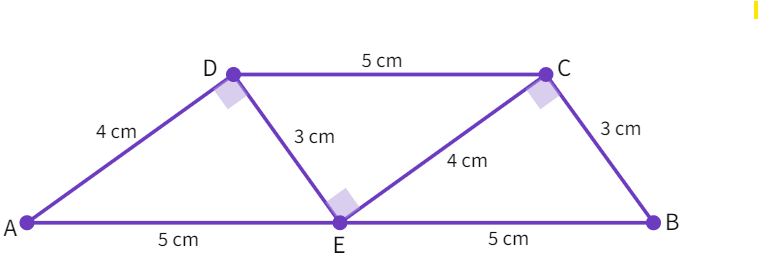
- Which are the parallel sides here?
- Are the non-parallel sides be equal?
- You have answered all the questions. Moving on.
Activity: Take four set-squares from the geometry box. As in the earlier example try to form different types of trapeziums.
Can we obtain an isoceles trapezium while carrying out this activity?
Using all the four set squares, we can get an iscosceles trapezium by arranging as given below:
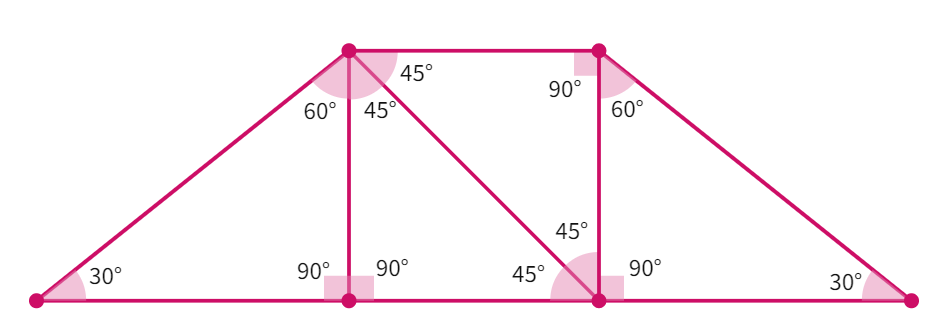
Kite
Kite is the type of a quadrilateral which has exactly two distinct consecutive pairs of sides of equal length.
Example of Kite Quadrilateral.
Note: The sides with the same markings in the above figure are equal. For example AB = AD and BC = CD.
(i) A kite has 4 sides (It is a quadrilateral).
(ii) There are exactly two distinct consecutive pairs of sides of equal length.
Think: Is a square also a kite?
Parallelogram
A parallelogram is a quadrilateral having opposite parallel sides.
Parallelogram.
Not a Parallelogram.
Now, is a rectangle also a parallelogram ?
Elements of a parallelogram
Now, let's discuss the properties of a parallelogram.
Parallelogram.
In the parallelogram ABCD figure given above:
- AB and DC and AD and BC are the
.
2. ∠A and ∠C and ∠B and ∠D form the pair of
3. AB and BC are
4. ∠A and ∠B and ∠B and ∠C are
Upon studying parallelograms, we find that:
Property: The opposite sides of a parallelogram are of equal length.
Opposite sides of a parallelogram
- Considering the triangles: ∆ABC and ∆ADC
- We see: ∠DAC = ∠
and ∠DCA = ∠ as they are angles - AC = AC as it is a
side - Therefore, ∆ ABC ≅ ∆ CDA by
congruency criterion. - Hence, AB =
and BC = - Therefore, we see that the opposite sides of a parallelogram are equal.
Try These
Take two identical set squares with angles 30° – 60° – 90° and place them adjacently to form a parallelogram as shown in Fig. Does this help you to verify the above property?
Property: The opposite sides of a parallelogram are of
As we can see in the figure above, the opposite sides of figure are equal.
The figure above is a
Example 3: Find the perimeter of the parallelogram PQRS.
Solution: In a parallelogram, the opposite sides have same length.
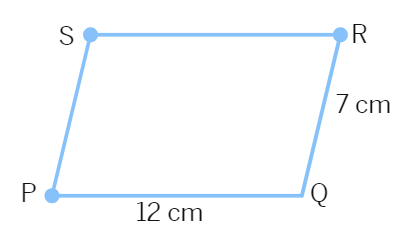
Therefore, PQ = SR =
So, Perimeter = PQ + QR + RS + SP = 12 cm + 7 cm + 12 cm + 7 cm =
Thus, the perimeter of the parallelogram PQRS is 38 cm.
Angles of a parallelogram
Moving on to the property concerning the (opposite) angles of a parallelogram.
Property: The opposite angles of a parallelogram are of equal measure.
Opposite angles of a parallelogram
- Considering the triangles- ∆ABC and ∆ADC , we know that ∆ ABC ≅ ∆ CDA by
congruency criterion. - Therefore, ∠ADC = ∠
. Similarly, if we join BD and consider the triangles- ∆ADB and ∆CBD, we get: ∠BAD = ∠ - Hence, opposite angles are equal for a parallelogram.
Try These
Take two identical 30° – 60° – 90° set squares and place them adjacently to form a parallelogram. Does the figure obtained help you to verify the above property?
Example 4: In the figure, BEST is a parallelogram. Find the values x, y and z.
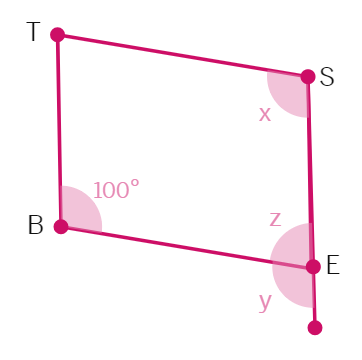
Solution: S is
So, x =
y =
z =
For the adjacent angles of a parallelogram:
Property: The adjacent angles in a parallelogram are supplementary.
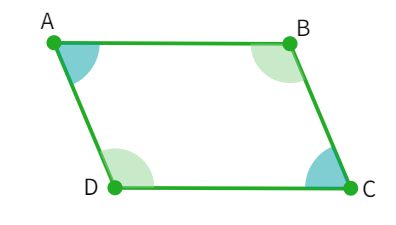
- We know that, the co-interior angles in a pair of parallel lines are
to each other. - As AB||DC with AD being the transverse cutting it, we can say: ∠A + ∠D =
° - Similarly, the side BC also acts like a
for the parallel sides AB and DC, giving ∠B + ∠C = ° - Now, as AD||BC are a pair of parallel lines with AB and DC as the transverse, we get: ∠A + ∠B = ∠D + ∠C =
° - Therefore, the sum of any two adjacent angles of a parallelogram is equal to 180°
Example 5: In a parallelogram RING, if m∠R = 70°, find all the other angles.
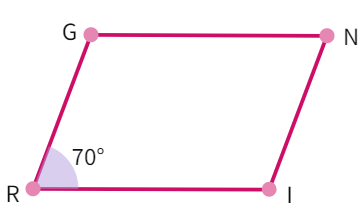
- From the figure, we know that: ∠N =
° - As the opposite angles of a parallelogram are equal. We also know that, Sum of any two adjacent angles of a parallelogram is equal to 180°.
- Therefore, ∠N + ∠I =
° - ∠I =
° - °. Thus, ∠I = ° - Thus, m∠I =
° m∠N = ° m∠G = °
After showing m∠R = m∠N = 70°, can you find m∠I and m∠G by any other method?
Alternate Solution: Using the formula for sum of interior angles of a polygon:
Sum of interior angles of a polygon = (n - 2) x 180°
where n is the number of sides
Putting n =
Sum of interior angles =
We know that, ∠I = ∠G from the parallelogram properties.
Therefore we have,
∠R + ∠I + ∠N + ∠G = 360°
70° + 2∠I + 70° = 360°
∠I =
Therefore,
∠I = ∠G = 110°
Diagonals of a parallelogram
Generally speaking, the diagonals of a parallelogram are not of equal length. However, the diagonals of a parallelogram share an interesting property.
Property: The diagonals of a parallelogram bisect each other with respect to the point of intersection.
Diagonals of a parallelogram
- Considering the triangles- ∆PQT and ∆SRT, we see that: PQ =
as they are sides of a parallelogram - We also have: ∠TPQ = ∠
and ∠TQP = ∠ as they are angles - Thus, by
congruency criterion- ∆ PQT ≅ ∆ - This means PT =
and RT = - Therefore, the diagonals of a parallelogram
each other.
Example 6: In the figure, HELP is a parallelogram. (Lengths are in cms). Given that OE = 4 and HL is 5 more than PE? Find OH.
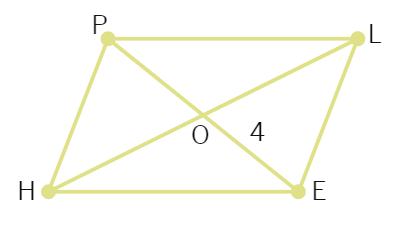
Solution: If OE = 4 then OP also is
So, PE =
Therefore, HL = 8 +
Hence OH =
Thus, OH = 6.5 (cms)
